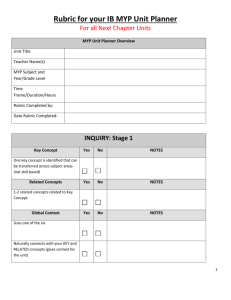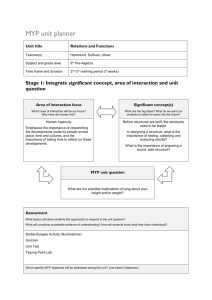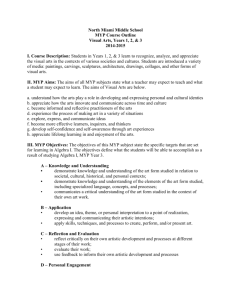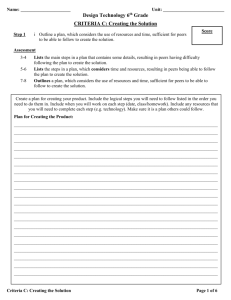Assessment Policy Power Point
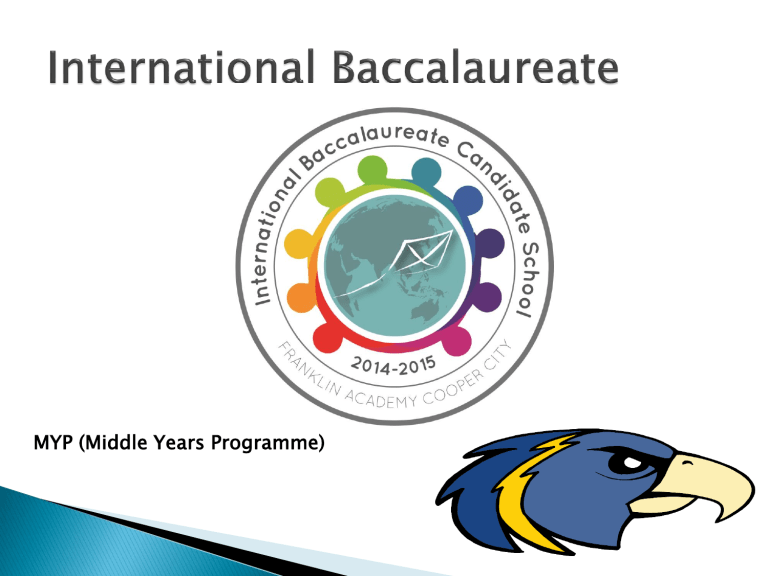
MYP (Middle Years Programme)
IB World Clocks
◦ Sydney, Rio De Janeiro, London, Dubai, Tokyo,
Paris, and Jerusalem
Penpal’s
◦ Ms. Lyons- Language and Literature- Lulea, Sweden
◦ Mr. Wall- Language and Literature- Linge, France
Franklin Academy first ever foreign exchange student from Argentina.
Educating the World to be Drug Free
Franklin Academy has already met the IB requirement that at least 1 teacher per subject group attend a category 1 workshop.
Teachers who attend IB trainings follow a train the trainer model to expose all MYP teachers with new information and practices.
◦ Los Angeles, California October 18 th -20 th , 2014
Mr. Pena- Individuals and Societies
Mr. Rodriguez- Math
◦ Portland, Oregon November 14 th -17 th , 2014
Mr. Francisco-Visual Arts
Ms. Fernandez- Performing Arts
Mrs. Cronin- Science
Mr. Souza-Physical and Health Education
◦ Chicago, Illinois, November 22 nd -24 th , 2014
Ms. Flynn-Language and Literature
◦ New Orleans, Louisiana December 12 th -15 th , 2015
Ms. Nugent- Design
Ms. Alegre- Language Acquisition
Teachers will
◦ Design appropriate, engaging, and rigorous units of study and assessments.
◦ Align assessments with stated learning objectives/criteria, inquiry questions, significant concepts, and approaches to learning skills.
◦ Provide students with clear rubrics and task specific clarifications at the beginning of each unit.
◦ Provide opportunities for students to reflect on their performance on a given assignment or assessment.
◦ Provide timely and meaningful feedback to students and parents/legal guardians of student progress and areas of growth.
◦ Collaboratively work together to maintain consistent assessment procedures (develop task-specific descriptors, standardized grading practices, Middle Years Programme (MYP) Unit Plans, and inquiry questions).
◦ Use professional judgment when determining levels of achievement.
Students will
◦ Do their best to exemplify the learner profile in their approaches to learning and assessments.
◦ Familiarize themselves with the criteria rubrics and learning objectives for each of their subject groups.
◦ Reflect on the content knowledge and skills that they are developing.
◦ Work meaningfully with teachers and peers to develop content knowledge and skills.
◦ Ask for assistance when needed.
◦ Actively participate in the inquiry and exploration in their global classrooms.
◦ Reflect on the feedback that teachers give on summative assessment rubrics, while setting goals that allow for continuous improvement.
Administrations and Leadership will
◦ Provide time, resources, and focus to teachers for maintenance of assessment policies.
◦ Provide time for collaborative planning.
◦ Conduct International Baccalaureate (IB) MYP meetings and subject group meetings.
◦ Provide opportunities for IB professional development workshops.
◦ Continually observe teachers using the IB observation document and provide feedback.
◦ Support a spirit of collaboration and collegiality among all stakeholders.
◦ Arrange parent and student conferences with all MYP teachers.
Parents and Guardians will
◦ Familiarize themselves with the criteria rubrics and learning objectives for each of their students’ courses. Rubrics can be found on the FACC website under the IB tab.
◦ Use those rubrics and objectives as the springboards for discussion about assessment with teachers, administrators, staff, and their children.
◦ Feel free to contact teachers at any time with questions they might have regarding assessment.
◦ Support their children’s academic and character growth throughout the MYP.
◦ Regularly check teacher websites and FACC website for IB updates.
◦ Communicate with teachers, students, and administrators/leadership/IB Coordinator/staff about questions or comments they have regarding their student’s progress in the
MYP.
◦ Attend IB parent nights.
A summative assessment is an open-ended task created by teachers. It allows for differentiation so students can demonstrate their knowledge and comprehension in a variety of ways using
MYP area objectives.
Summative assessments are authentic, learnercentered and inquiry based. It is created for the end of a specific unit of study and allows students to apply their understanding and skills.
Summative assessments are used as an evaluation of the individual student’s achievement of objectives/ criteria and standards through an end-of-unit culminating project.
A
(8)
B
(8)
C
(8)
Each subject group in the MYP has 4 objectives (A,B,C,D).
Objectives are different for each subject group but remain the same for all years of that subject groups.
Subject
Group:
Individuals and
Societies
Language and
Literature
Language
Acquisition
Mathematics Physical and Health
Education
Sciences Design Arts
Knowing and
Understanding
Analyzing Comprehending spoken & Visual Text
Knowledge and
Understanding
Knowing and
Understanding
Knowledge and
Understanding
Inquiring and
Analyzing
Knowing and
Understanding
Investigating Organizing Comprehending
Written & Visual Text
Investigating patterns
Planning for
Performance
Communicating Producing text Communicating in response to spoken, written, and visual text
Communication in mathematics
Applying and
Performing
Inquiring and
Designing
Developing ideas
Developing Skills
Process and evaluative
Creating the
Solution
Thinking creatively
D
(8)
Thinking critically Using
Language
Using language Applying mathematics in real world contexts
Reflection and
Improving
Performance
Reflects on the impacts of sciences
Evaluating Responding
Summative assessments are always graded against IB rubrics which have pre-determined criteria.
All rubrics are graded on a scale of 0-8.
IB has published the criteria and their descriptors for the different achievement levels in all assessment rubrics for each subject group for year 1 (6 th grade), year 3 (7 th grade), and year 5 (10 th grade).
IB rubrics are holistic and do not require mastery of each level descriptor but a graded as a “best fit” method.
Think of a bucket being filled with water when thinking about how
IB rubrics are graded.
Teachers are expected to provide students with clear rubrics and task specific clarifications at the beginning of each unit.
Teachers are expected to use their professional judgment based to determine IB achievement levels.
Each objective (A,B,C,D) for each subject group is broken into different achievement levels with numerical values from 0-8. Each achievement level has specific level descriptors that describe what a students needs to do to attain a specific achievement level.
0
Achievement level
Level descriptor Task-Specific Clarifications
1-2
The student does not reach a standard described by any of the descriptors below.
The student: i. recognizes some vocabulary ii. demonstrates basic knowledge and understanding of content and concepts through limited descriptions and/or examples.
3-4
5-6
7–8
The student: i. uses some vocabulary ii. demonstrates satisfactory knowledge and understanding of content and concepts through simple descriptions, explanations and/or examples.
The student: i. uses considerable relevant vocabulary, often accurately ii. demonstrates substantial knowledge and understanding of content and concepts through descriptions, explanations and examples.
The student: i. consistently uses relevant vocabulary accurately ii. demonstrates excellent knowledge and understanding of content and concepts through detailed descriptions, explanations and examples.
Achiev ement level
Level descriptor
7–8 1.The student: consistently uses a wide range of terminology effectively.
II. demonstrates detailed knowledge and understanding of content and concepts through thorough descriptions, explanations and examples.
Task-specific clarification
1.You consistently use terminology such as “industrialization”,
“enclosure”, “domestic system” and
“urbanization” effectively.
II. You demonstrate detailed knowledge and understanding of the concept of change in the context of the Industrial Revolution through thorough accurate descriptions about changes in industry and the production system, explanations about how these affected social life and examples of resistance to these changes .
http://xmltwo.ibo.org/publications/MYP/m_3
_indivsoc_tsm_1406_1/PDF/example4_task_s heet_indivsoc_en.pdf
IB MYP command terms are embedded in the objectives and assessment criteria of each subject area in the MYP.
IB MYP command terms are common practices across all subject groups.
The goal of command terms is to have students understand what to do when asked to “recognize” as opposed to “demonstrate.”
Sample Rubric 1-2
◦ The student:
◦ i. recognizes some vocabulary
◦ ii. demonstrates basic knowledge and understanding of content and concepts through limited descriptions and/or examples.
Parents can have a key role in learning command terms.
A student has earned a score of 4 on their summative assessment, but what does that mean?
IB Achievement Level Percent Score
8 95-100
7 90-94
6 85-89
5 80-84
4 75-79
3 70-74
2
1
65-69
60-64
0 59-0
By the end of the school year, each IB teacher must assess each criteria/objective for his/her particular subject group at least twice. Final IB course grades are not averaged. They are determined by the professional judgment of teachers based on the entire body of evidence as well as the ongoing learning process.
Project
Research
Paper
Test
Project
Total
Objective A-
Knowing and
Understanding
2
4
6
5
Objective B-
Investigating
3
5
4
Objective C-
Communicating
4
5
5
Objective D-
Thinking
Critically
3
5
6
6
Final Points=
20
Final Mark Boundary Guidelines
1 1-5
2
3
4
5
6
7
6-9
10-14
15-18
19-23
24-27
28-32
Descriptor
Produces work of very limited quality. Conveys many significant misunderstandings or lacks understanding of most concepts and contests. Very rarely demonstrates critical or creative thinking. Very inflexible, rarely using knowledge or skills.
Produces work of limited quality. Expresses misunderstandings or significant gaps in understanding for many concepts and contexts. Infrequently demonstrates critical or creative thinking. Generally inflexible in the use of knowledge and skills, infrequently applying knowledge and skills.
Produces work of an acceptable quality. Communicates basic understanding of many concepts and contexts, with occasionally significant misunderstandings or gaps. Begins to demonstrate some basic critical and creative thinking. Is often inflexible in the use of knowledge and skills, requiring support even in familiar classroom situations.
Produces good-quality work. Communicates basic understanding of most concepts and contexts with few misunderstandings and minor gaps. Often demonstrates basic critical and creative thinking. Uses knowledge and skills with some flexibility in familiar classroom situations, but requires support in unfamiliar situations.
Produces generally high-quality work. Communicates secure understanding of concepts and contexts.
Demonstrates critical and creative thinking, sometimes with sophistication. Uses knowledge and skills in familiar classroom and real-world situations, and, with support, some unfamiliar real-world situations.
Produces high-quality, occasionally innovative work. Communicates extensive understanding of concepts and contexts. Demonstrates critical and creative thinking, frequently with sophistication. Uses knowledge and skills in familiar and unfamiliar classroom and real-world situations, often with independence.
Produces high-quality, frequently innovative work. Communicates comprehensive, nuanced understanding of concepts and contexts. Consistently demonstrates sophisticated critical and creative thinking. Frequently transfers knowledge and skills with independence and expertise in a variety of complex classroom and real-world situations.
Step 1- A teacher provides students with an IB rubric that outlines the assessment criteria and task specific clarifications that will be assessed at the beginning of each new unit.
Step 2- The teacher grades the summative assessment based on the appropriate rubric and provides student feedback on the assessment criteria.
Step 3- The process is repeated throughout the year so that all criterion and strands in every subject group are covered at least two times.
Step 4- At the end of the year, each teacher analyzes the student’s overall body of work and the ongoing learning throughout the year and uses professional judgment to award an overall mark for each individual criterion.
Step 5- The criterion levels in each subject group are then added together to give a final mark and score out of seven for each subject group. There are equivalent level descriptions for each score from 1-7.
Step 6- Teachers add together the student’s final achievement levels in all four criteria’s. Teachers then use IB grade boundaries to determine final grades in each year of the MYP.
Continue full implementation of IB; curriculum, grades, IB learner profile attributes, creating a global atmosphere.
IB consultant mid-year visit in late April or early May.
Application for authorization opens August
15th, 2015 and is due October 1
st
, 2015.
Spring 2016 IB visit, 3-4 months later receive official decision on IB World School status.
Familiarize yourself with IB subject group rubrics for years 1,3 and 5. These can be found online.
Familiarize yourself with MYP command terms.
Continue to explore the global world with students, fostering inquiry and exploration.
Check our website frequently for news and updates.
◦ http://cc.franklin-academy.org/
![IB UNIT PLAN 6th Egypt and African Kingdoms[1].](http://s3.studylib.net/store/data/007841585_2-96830c69aa78f551c350cd09ec222ab7-300x300.png)
